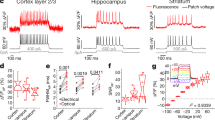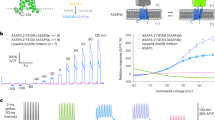Abstract
Cortical information processing relies on synaptic interactions between diverse classes of neurons with distinct electrophysiological and connection properties. Uncovering the operational principles of these elaborate circuits requires the probing of electrical activity from selected populations of defined neurons. Here we show that genetically encoded voltage-sensitive fluorescent proteins (VSFPs) provide an optical voltage report from targeted neurons in culture, acute brain slices and living mice. By expressing VSFPs in pyramidal cells of mouse somatosensory cortex, we also demonstrate that these probes can report cortical electrical responses to single sensory stimuli in vivo. These protein-based voltage probes will facilitate the analysis of cortical circuits in genetically defined cell populations and are hence a valuable addition to the optogenetic toolbox.
This is a preview of subscription content, access via your institution
Access options
Subscribe to this journal
Receive 12 print issues and online access
$259.00 per year
only $21.58 per issue
Buy this article
- Purchase on Springer Link
- Instant access to full article PDF
Prices may be subject to local taxes which are calculated during checkout






Similar content being viewed by others
References
Grinvald, A. & Hildesheim, R. VSDI: a new era in functional imaging of cortical dynamics. Nat. Rev. Neurosci. 5, 874–885 (2004).
Knöpfel, T., Diez-Garcia, J. & Akemann, W. Optical probing of neuronal circuit dynamics. Trends Neurosci. 29, 4602–4612 (2006).
Dimitrov, D. et al. Engineering and characterization of an enhanced fluorescent protein voltage sensor. PLoS One 2, e440 (2007).
Perron, A. et al. Second and third generation voltage-sensitive fluorescent proteins for monitoring membrane potential. Front. Mol. Neurosci. 2, 5 (2009).
Sakai, R., Repunte-Canonigo, V., Raj, C.D. & Knöpfel, T. Design and characterization of a DNA-encoded, voltage-sensitive fluorescent protein. Eur. J. Neurosci. 13, 2314–2318 (2001).
Murata, Y., Iwasaki, H., Sasaki, M., Inaba, K. & Okamura, Y. Phosphoinositide phosphatase activity coupled to an intrinsic voltage sensor. Nature 435, 1239–1243 (2005).
Mutoh, H. et al. Spectrally-resolved response properties of the three most advanced FRET based fluorescent protein voltage probes. PLoS One 4, e4555 (2009).
Hatanaka, Y., Hisanaga, S.I., Heizmann, C.W. & Murakami, F. Distinct migratory behavior of early- and late-born neurons derived from the cortical ventricular zone. J. Comp. Neurol. 479, 1–14 (2004).
Akemann, W., Lundby, A., Mutoh, H. & Knopfel, T. Effect of voltage sensitive fluorescent proteins on neuronal excitability. Biophys. J. 96, 3959–3976 (2009).
Petersen, C.C., Grinvald, A. & Sakmann, B. Spatiotemporal dynamics of sensory responses in layer 2/3 of rat barrel cortex measured in vivo by voltage-sensitive dye imaging combined with whole-cell voltage recordings and neuron reconstructions. J. Neurosci. 23, 1298–1309 (2003).
Ferezou, I., Bolea, S. & Petersen, C.C. Visualizing the cortical representation of whisker touch: voltage-sensitive dye imaging in freely moving mice. Neuron 50, 617–629 (2006).
Ferezou, I. et al. Spatiotemporal dynamics of cortical sensorimotor integration in behaving mice. Neuron 56, 907–923 (2007).
Palmer, A.E. et al. Ca2+ indicators based on computationally redesigned calmodulin-peptide pairs. Chem. Biol. 13, 521–530 (2006).
Mennerick, S. et al. Diverse voltage-sensitive dyes modulate GABAA receptor function. J. Neurosci. 30, 2871–2879 (2010).
Chanda, B. et al. A hybrid approach to measuring electrical activity in genetically specified neurons. Nat. Neurosci. 8, 1619–1626 (2005).
Sjulson, L. & Miesenbock, G. Rational optimization and imaging in vivo of a genetically encoded optical voltage reporter. J. Neurosci. 28, 5582–5593 (2008).
Perron, A., Mutoh, H., Launey, T. & Knöpfel, T. Red-shifted voltage-sensitive fluorescent proteins. Chem. Biol. 16, 1268–1277 (2009).
Manns, I.D., Sakmann, B. & Brecht, M. Sub- and suprathreshold receptive field properties of pyramidal neurones in layers 5A and 5B of rat somatosensory barrel cortex. J. Physiol. (Lond.) 556, 601–622 (2004).
Crochet, S. & Petersen, C.C. Correlating whisker behavior with membrane potential in barrel cortex of awake mice. Nat. Neurosci. 9, 608–610 (2006).
Katayama, H., Yamamoto, A., Mizushima, N., Yoshimori, T. & Miyawaki, A. GFP-like proteins stably accumulate in lysosomes. Cell Struct. Funct. 33, 1–12 (2008).
Tsutsui, H., Karasawa, S., Okamura, Y. & Miyawaki, A. Improving membrane voltage measurements using FRET with new fluorescent proteins. Nat. Methods 5, 683–685 (2008).
Sauer, B. & Henderson, N. Site-specific DNA recombination in mammalian cells by the Cre recombinase of bacteriophage P1. Proc. Natl. Acad. Sci. USA 85, 5166–5170 (1988).
Akagi, K. et al. Cre-mediated somatic site-specific recombination in mice. Nucleic Acids Res. 25, 1766–1773 (1997).
Cossart, R., Ikegaya, Y. & Yuste, R. Calcium imaging of cortical networks dynamics. Cell Calcium 37, 451–457 (2005).
Lutz, C. et al. Holographic photolysis of caged neurotransmitters. Nat. Methods 5, 821–827 (2008).
Nikolenko, V. et al. SLM microscopy: scanless two-photon imaging and photostimulation with spatial light modulators. Front. Neural Circuits. 2, 5 (2008).
Lundby, A., Mutoh, H., Dimitrov, D., Akemann, W. & Knöpfel, T. Engineering of a genetically encodable fluorescent voltage sensor exploiting fast Ci-VSP voltage-sensing movements. PLoS One 3, e2514 (2008).
Matsuda, T. & Cepko, C.L. Electroporation and RNA interference in the rodent retina in vivo and in vitro. Proc. Natl. Acad. Sci. USA 101, 16–22 (2004).
Shaner, N.C. et al. Improved monomeric red, orange and yellow fluorescent proteins devrived from Discosoma sp. red fluorescent protein. Nat. Biotechnol. 22, 1567–1572 (2004).
Shimogori, T. & Ogawa, M. Gene application with in utero electroporation in mouse embryonic brain. Dev. Growth Differ. 50, 499–506 (2008).
Acknowledgements
We thank all members of the Knöpfel laboratory for comments and invaluable technical help, T. Shimogori and R. Yoshida for in utero electroporation of VSFP plasmids, and Thomas Behnisch for his participation in initial in vivo experiments. This work was funded by grants from RIKEN Brain Science Institute (T.K.), the RIKEN Brain Science Institute director's fund (T.K.), US National Institutes of Health grant NS057631 (T.K.), a grant from the Ministry of Education, Culture, Sports, Science and Technology (MEXT, H.M.), the Japanese Society for the Promotion of Science–Canadian Institutes of Health Research postdoctoral fellowship program (A.P.), a grant-in-aid for Japanese Society for the Promotion of Science fellows (A.P.) and La Fondation pour les Sciences du Cerveau (J.R.).
Author information
Authors and Affiliations
Contributions
W.A., H.M., A.P. and T.K. conceived and designed the experiments. A.P. developed VSFP2.42. H.M. performed recordings in cultured cells. W.A. performed experiments in acute brain slices. W.A., H.M. and T.K. performed in vivo imaging experiments. W.A., H.M., A.P., J.R. and T.K. contributed to data analysis, preparation of figures and writing of the manuscript.
Corresponding author
Ethics declarations
Competing interests
The authors declare no competing financial interests.
Supplementary information
Supplementary Text and Figures
Supplementary Figures 1–6 and Supplementary Table 1 (PDF 399 kb)
Rights and permissions
About this article
Cite this article
Akemann, W., Mutoh, H., Perron, A. et al. Imaging brain electric signals with genetically targeted voltage-sensitive fluorescent proteins. Nat Methods 7, 643–649 (2010). https://doi.org/10.1038/nmeth.1479
Received:
Accepted:
Published:
Issue Date:
DOI: https://doi.org/10.1038/nmeth.1479
This article is cited by
-
Video-based pooled screening yields improved far-red genetically encoded voltage indicators
Nature Methods (2023)
-
Complexity of cortical wave patterns of the wake mouse cortex
Nature Communications (2023)
-
Widefield imaging of rapid pan-cortical voltage dynamics with an indicator evolved for one-photon microscopy
Nature Communications (2023)
-
Fluorescence-amplified nanocrystals in the second near-infrared window for in vivo real-time dynamic multiplexed imaging
Nature Nanotechnology (2023)
-
Structural and functional imaging of brains
Science China Chemistry (2023)



